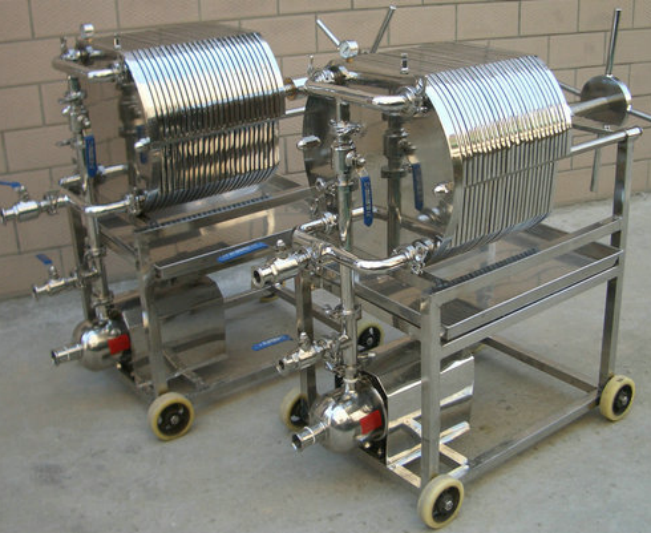
In modern beer enterprises, there are many types of diatomite filters, among which the plate-and-frame type, candle type, and horizontal disc type are the most common.
Ⅱ. The operation of diatomaceous earth filter
In modern beer enterprises, there are many types of diatomite filters, among which the plate-and-frame type, candle type, and horizontal disc type are the most common.
1. Plate and frame diatomite filter
The plate and frame diatomite filter is composed of a frame and filter frames and filter plates suspended on it alternately, and the material is mostly stainless steel. Support plates are suspended on both sides of the filter plate, and the filter frame and filter plate are sealed to each other. The support board is made of fiber and condensed resin.
The plate and frame diatomite filter consists of alternately installed filter frames and filter plates. Since the support plates can be hung on both sides of the filter plate, a certain space is formed between the two support plates and the filter frame therebetween after the filter is pressed and installed. This "space" is filled with diatomaceous earth, filtered yeast and other impurities. The diatomite during pre-coating and continuous feeding is pumped into the filter frame from above or below by the metering device. As the filtration progresses, the diatomite coating will become thicker and thicker.
The filter cardboard is generally strengthened through the overall strengthening technology, and its strength is greatly increased. After the filter is finished and the diatomaceous earth is washed down, the cardboard can be reused.
2. Candle diatomaceous earth filter
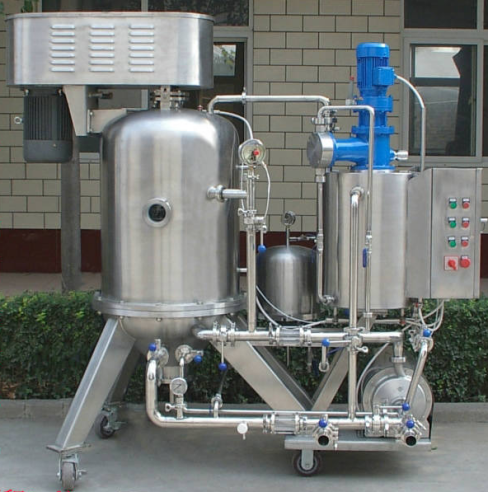
(1) candle wick
The filter candle wick is a filter material, and the filter aid-diatomaceous earth is pre-coated on the candle wick. For filtering, the helix is wound around the wick in the radial direction, and the distance between the wires is 50~80um. The filter wick can be as long as 2m or more. Since nearly 700 candle wicks are installed in the filter, the filter area formed is very large, the filtration efficiency is very high, and there are no moving parts on the wick.
(2) Filtration area of the candle wick
A. A candle wick with a length of 1.5m and a diameter of 25mm has a filtration area of 0.118m 2 .
B. A candle wick with a length of 1.5m and a diameter of 30mm has a filtration area of 0.141m 2 .
C. A candle wick with a length of 2.0 m and a diameter of 35 mm has a filtration area of 0.22 m 2 .
(3) Working process of candle diatomite filter
The main body of the candle type diatomite filter is a vertical pressure tank with an upper column and a lower cone. There is a candle wick bottom plate under the machine cover of this type of filter, on which the suspended candle wick is fixed, and a series of auxiliary equipment such as pipelines, connectors and testing instruments are equipped. Care should be taken with these ancillary equipment to ensure minimal oxygen uptake during and after filtration. The working process of the candle type diatomite filter is as follows:
A. Fill the filter. Since the water will come into contact with the beer, use deoxygenated water. Water is in circulation.
B. Precoat. For the first pre-coating, filter aid—diatomaceous earth is mixed with water, and pre-coated on the candle wick for about 10 minutes until a support layer is formed. The effluent was cloudy at the beginning of the first precoat. Followed by the second pre-painting with the same method.
C. Loop. After each pre-coating, the entire filtration equipment should be circulated for 10 - 15 minutes.
D. Start filtering. First the water is pushed out by the beer. The beer to be filtered slowly pushes out of the water in the filter machine from bottom to top, and is filtered through the candle wick. Then, the diatomaceous earth liquid is quantitatively added to the beer through a metering pump. Note that although the contact interface between water and beer is very small, there will inevitably be a part of the wine-water mixture, which is the so-called wine head.
E. Beer filtration. Due to the continuous addition of diatomite, the diatomite layer on the candle wick is getting thicker and the filtration accuracy is getting higher and higher. However, the pressure on the import side is also getting higher and higher. When the allowable maximum pressure of 0.5-0.6MPa is reached , the filtration must be stopped.
F. Filtration ends. After the filtration, the beer is pushed out by the deoxygenated water entering from the lower part. At this time, a mixture of beer and water will be produced, which is the so-called tail.
G. Discharge soil. The waste diatomite is in the form of thick mud or thin liquid, and the diatomite is pressed out from the candle wick with compressed air.
H. Cleaning. Wash in the opposite direction of filtration. At this time, air is mixed with water in an intermittent manner, forming a vortex on the candle wick, generating air impact, and washing the candle wick cleanly.
I. Sterilization. Finally, sterilize the filter, all connections and pipes with hot water. After that, the filter can be put into the next beer filtration again.
3. Horizontal disc diatomite filter
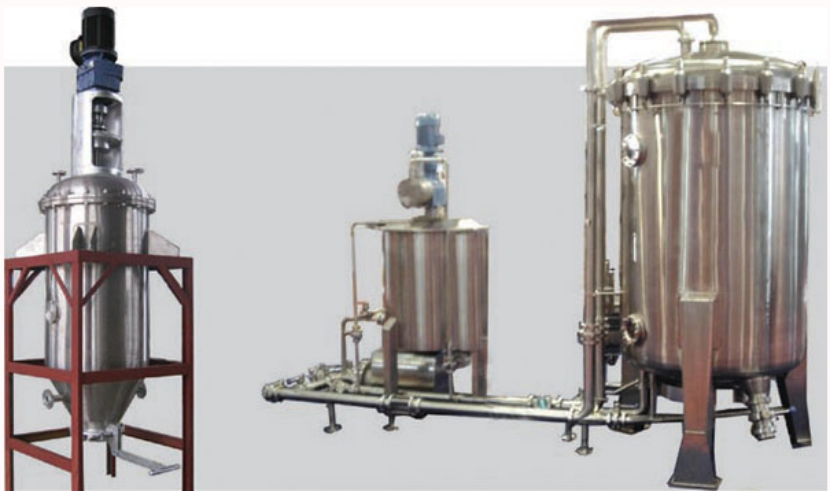
Horizontal disc diatomite filter is also called leaf filter. In the filter machine, there is a hollow shaft, and multiple discs (filter units) are fixed on the hollow shaft, and the discs are used for filtering.
diatomite filter, the filter support material is a filter disc woven with chrome-nickel steel material, and the pore size of the metal screen is 50-80μm . This filter is only fixed with a layer of metal screen on the upper surface of the horizontal disc.
It is evident that diatomaceous earth adheres well to the horizontal disks. It works on the same principle as a candle diatomaceous earth filter (exhaust with deoxygenated water, two precoats, continuous addition of diatomaceous earth while filtering). The added diatomaceous earth is evenly distributed on each disc, thereby forming a uniform filter layer. However, it was still difficult to distribute the diatomaceous earth coating completely evenly on all the filter discs.
The muddy waste diatomaceous earth can be discharged by the centrifugal force generated by the rotating filter disc. There are usually several different rotational speeds to choose from. When cleaning, the rotation speed of the filter disc is very slow, and the disc is strongly washed while rotating.
There are two channels on the hollow shaft of the new horizontal disc diatomite filter. Through it, the pre-coating and filtering process can be uninterrupted.
When filtering with a diatomite filter, filter aids such as diatomaceous earth or perlite are coated on the filter support material. Precoating is necessary because the continuously added filter aid particles are too fine to be retained by the filter material. Filtration can only be performed after the precoating is complete. During the filtration process, the filter aid should be continuously added until the filtration is completed. As the filtration progresses, the filter layer becomes thicker and thicker, the pressure difference between the inlet and outlet of the filter becomes larger and larger, and its filtration capacity becomes smaller and smaller until the final filtration ends.
1. Prepainted
Diatomaceous earth filtration requires woven fabrics with a pore width of 70-100μm or other filter materials with very fine pores, which are much larger than diatomite with a pore width of 2-4μm . If the beer is directly filtered and diatomite is added, the diatomite will definitely pass through the filter material unimpeded and be lost, and the filtered beer is even more turbid than before filtration. In order to achieve the perfect filtering effect, the filter aid must be added in 3 times to form three filter-aid layers to form the whole filter layer.
(1) First pre-coat
0.2 - 0.3MPa, mix deoxygenated water or filtered wine with a certain amount of coarse soil, and pre-coat in a circular manner, thereby forming a pressure-stable base pre-coat. The first precoat is very critical, it does not act as a filter, but it acts as a support.
The amount of coarse diatomaceous earth used for pre-coating this time is 0.7 - 0.8kg/m 2 , which is about 70% of the entire pre-coating amount.
(2) Second pre-coat
The role of the second pre-coat is to clear the wine that was first filtered off. This pre-coating still uses deoxygenated water or filtered wine and filter aids. Diatomaceous earth is finer and has filter activity. This can not only trap turbid substances, but also prevent the filter from clogging. The pre-coating should be evenly distributed, otherwise it will cause the flow rate of the beer liquid to be unstable and even cloudy.
The total soil amount for pre-coating is 0.8-1kg/m 2 , and the pre-coating thickness is 2-3mm. The pre-coating process generally takes 15 to 20 minutes.
(3) Continuous feeding
After the pre-coating is finished, the filtration begins. During the filtration, the filter aid should be added continuously. Its function is to continuously update the filter layer to maintain the permeability of the filter layer and keep the flow rate constant. The flow must be kept constant, because the pressure of the liquid and the unevenness of the liquid flow will destroy the "filter bridge" on the sieve or candle surface, and the filtered wine will become turbid again, so this situation must be avoided. Whether the flow is uniform or not depends on the pressure difference between the inlet and outlet of the filter. Under normal circumstances, the pressure difference should rise slowly and continuously until the pressure difference of the plate and frame diatomite filter is 0.2 ~ 0.5MPa, and the pressure difference of the leaf diatomite filter is 0.3 ~ 0.5MPa, and the filtration should end.
Under normal circumstances, the rate of rise of the filter pressure difference is 0.02 - 0.03MPa/h. The brewery can generally determine the composition of the mixed diatomite according to the experience of the enterprise. When feeding continuously, two kinds of diatomite are used in combination, with medium soil accounting for 2/3 and fine soil accounting for 1/3.
The amount of diatomaceous earth used for continuous feeding is 0.8~1.4kg/kL beer.
2. Head and tail treatment
Regardless of the filtration method, wine heads and tails will be produced, but the amount produced is the least in the leaf filter, more in the candle type diatomite filter, and the most in the plate and frame type diatomite filter.
When done correctly, the quality of the head and tail is not bad, but the original concentration is slightly lower. The head and tail of the wine can be used to adjust the original concentration. Otherwise, high sparkling wine must be added, fermented in special residual tanks, mixed with normal beer and filtered.
3. Dosing of diatomaceous earth
The mixture of diatomite and deoxygenated water during pre-coating and the continuous addition of diatomite during filtration are all metered by metering devices.
Diatomaceous earth addition tank with agitator. The speed requirement for pre-coating is very high, so a circulating pump needs to be installed separately. When adding continuously, a piston membrane pump is used to accurately adjust the adding flow rate during filtration. The metering pump is also called the piston membrane pump, and its key component is the rubber membrane, which vibrates through the piston. The movement of the piston to the right forces the membrane to move to the right as well, and the resulting pressure presses the lower ball to lock the lower valve ball, while the upper valve ball is raised, thus forming the upper free addition channel. When the piston and membrane move to the left, the upper valve ball locks the upper adding channel, while the lower valve ball lifts up, thus forming the lower free adding
channel.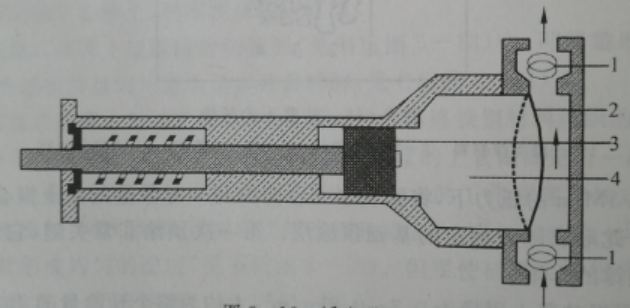
The vibration degree of the membrane is changed by using the amplitude of the piston operation, thereby changing the amount of diatomaceous earth and beer mixture added. The amplitude of the piston is adjusted by the manual nut, and the metering value can be read directly at the intersection of the shaft and the adjusting nut.
4. Problems prone to occur in diatomaceous earth filtration operation
The normal rise of pressure difference during normal filtration should be close to a straight line, about 0.02MPa/h.
(1) The failure during filtration often occurs in the process of emptying after pre-coating, and the filter layer is sometimes damaged.
(2) The amount of diatomaceous earth added is too low, and the yeast cannot mix with diatomaceous earth to form an additional support layer. This part of the yeast forms an insulating layer that, over time, causes the pressure to build up too quickly.
(3) The yeast shock generated during filtration comes from large yeast clumps, which form slight or severe blockages in the filter layer. The severity of yeast clogging can be shown on the curve of differential pressure change.
(4) If the amount of diatomite added is too high, the filtration curve will be too flat, and the filter cavity will be filled with diatomite in advance, resulting in difficulty in filtration.
Shandong Zeren Machinery Equipment Co., Ltd. is an equipment manufacturer focusing on biological fermentation industry
Copyright © Shandong Zeren Machinery Equipment Co., Ltd. All Rights Reserved |
Sitemap
| Technical Support:

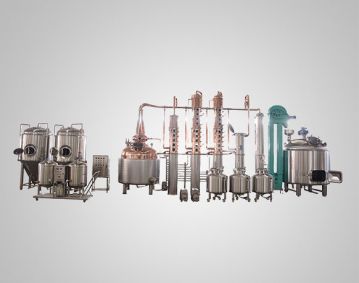 1500L Vodka Distiller
1500L Vodka Distiller
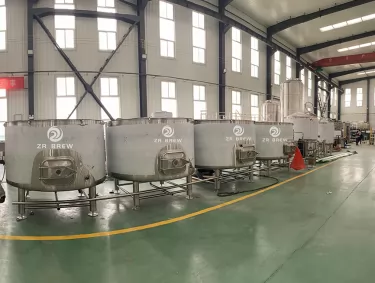 Kambucha Brewing Equipment
Kambucha Brewing Equipment
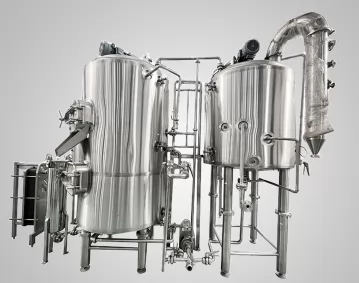 500L Nano Brewing Equipment
500L Nano Brewing Equipment
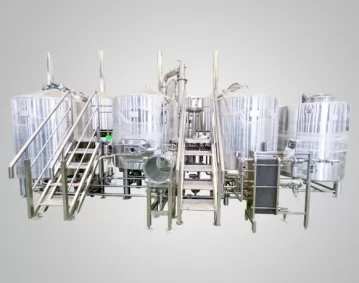 1000l 4 vessels beer brewing equipment system
1000l 4 vessels beer brewing equipment system
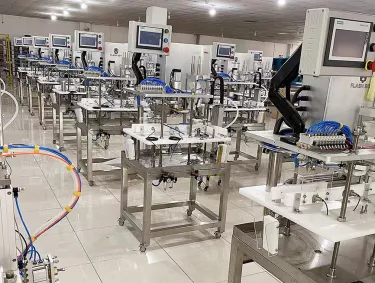 Semi-auto Can Washing & Filling & Capping Machine
Semi-auto Can Washing & Filling & Capping Machine
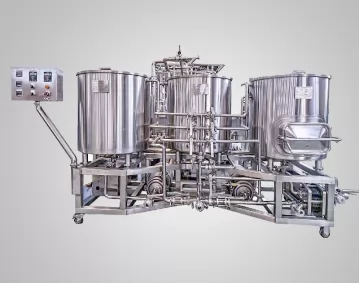 150L home brewery
150L home brewery
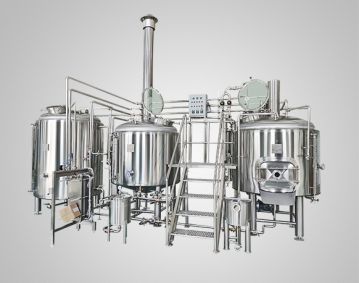 1000L brewery equipment
1000L brewery equipment
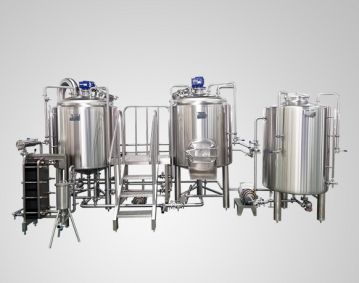 500L Brewery Equipment
500L Brewery Equipment
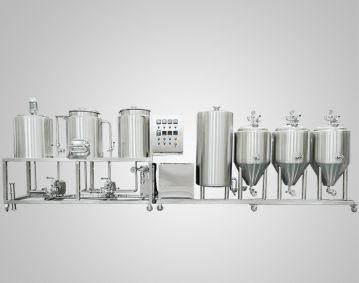 150L home brewing equipment
150L home brewing equipment
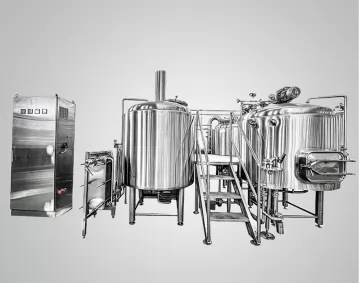 1500L 4 Vessle Brewery Equipment
1500L 4 Vessle Brewery Equipment
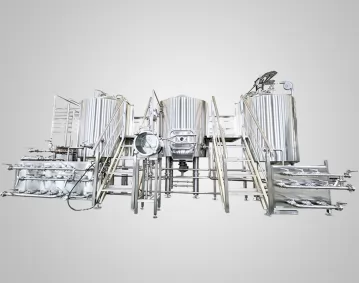 1000L Brewery Equipment
1000L Brewery Equipment
 50L small brewery
50L small brewery
 100L home brewery
100L home brewery
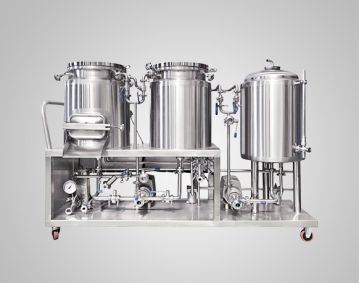 100L home brewing equipment
100L home brewing equipment
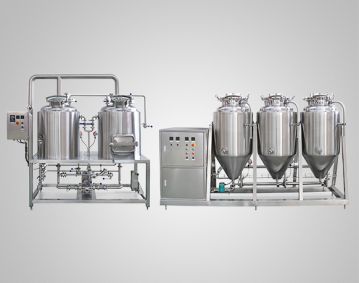 60L home brewing equipment
60L home brewing equipment
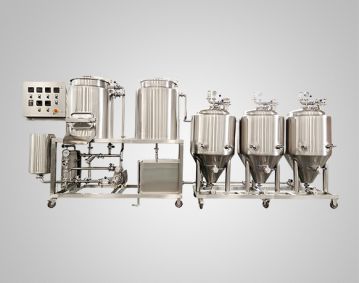 50L/100L home brewing equipment
50L/100L home brewing equipment
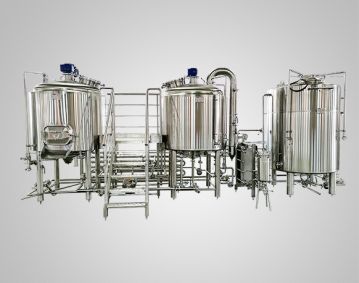 800L Brewery Equipment
800L Brewery Equipment
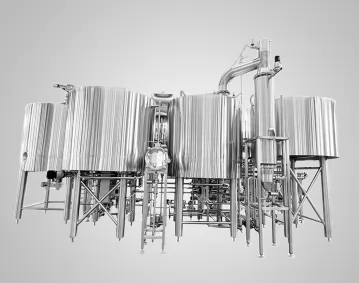 2500L Turnkey Brewery
2500L Turnkey Brewery
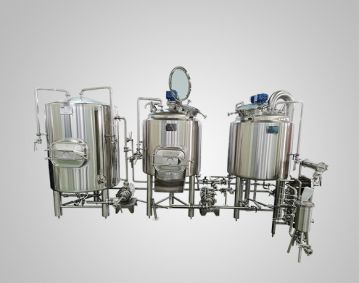 300L brewery equipment
300L brewery equipment
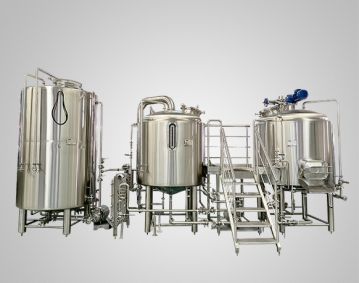 1000L brewery equipment
1000L brewery equipment
 50L home brewing equipment
50L home brewing equipment
